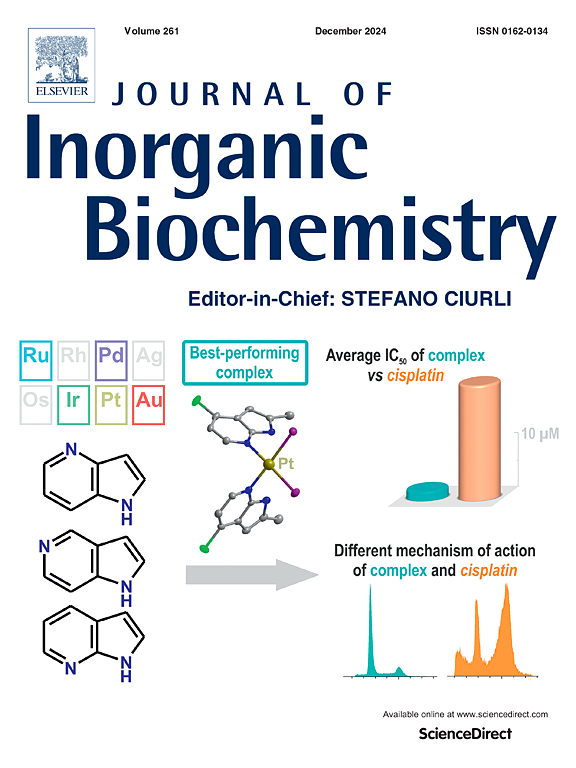New oxaliplatin-zoledronate derivatives with potential antitumor activity towards bone tumors and metastases
IF 3.2
2区 化学
Q2 BIOCHEMISTRY & MOLECULAR BIOLOGY
引用次数: 0
Abstract
Bone cancer can originate from any cellular element of the bone and may occur sporadically or as a result of degeneration from a precursor lesion. Bone metastases, often stemming from primary cancers such as breast and prostate cancer, are extremely painful and challenging to treat. The treatment of primary bone malignancies typically involves surgery, radiotherapy, chemotherapy and analgesics. Platinum (Pt)-based drugs are effective against bone cancers and metastases but are often limited by severe side effects due to poor specificity. To improve drug targeting and reduce systemic toxicity, bisphosphonate (BP) ligands, which selectively accumulate in bone tissue, have been combined with Pt-based drugs. The combination of Pt drugs with bisphosphonates like zoledronic acid (ZL) could lead to enhanced therapeutic outcomes due to its intrinsic pharmacological activity. In this study, we report the synthesis and full characterization of two new dinuclear Pt(II) complexes that combine ZL with clinically approved oxaliplatin and the drug-candidate kiteplatin, respectively. These complexes were tested for their stability under physiological and acidic conditions, reactivity with 5’-GMP interaction with B- and G-quadruplex DNA models and cytotoxicity against a panel of human tumor cell lines.

新的奥沙利铂-唑来膦酸盐衍生物对骨肿瘤和转移瘤具有潜在的抗肿瘤活性
骨癌可源于骨骼的任何细胞成分,可能偶发,也可能是前驱病变退化的结果。骨转移通常源于乳腺癌和前列腺癌等原发性癌症,会给患者带来极大的痛苦,治疗起来也极具挑战性。原发性骨恶性肿瘤的治疗通常包括手术、放疗、化疗和止痛药。以铂(Pt)为基础的药物对骨癌和骨转移有效,但由于特异性差,往往受到严重副作用的限制。为了提高药物的靶向性并减少全身毒性,人们将选择性积聚在骨组织中的双膦酸盐(BP)配体与铂类药物相结合。铂类药物与双膦酸盐(如唑来膦酸)(ZL)的结合可因其内在药理活性而提高治疗效果。在本研究中,我们报告了两种新型双核铂(II)配合物的合成和全面表征,它们分别将 ZL 与临床批准的奥沙利铂和候选药物基铂结合在一起。我们测试了这些复合物在生理和酸性条件下的稳定性、与 5'-GMP 的反应性、与 B 型和 G 型四联 DNA 模型的相互作用以及对人类肿瘤细胞系的细胞毒性。
本文章由计算机程序翻译,如有差异,请以英文原文为准。
求助全文
约1分钟内获得全文
求助全文
来源期刊

Journal of Inorganic Biochemistry
生物-生化与分子生物学
CiteScore
7.00
自引率
10.30%
发文量
336
审稿时长
41 days
期刊介绍:
The Journal of Inorganic Biochemistry is an established international forum for research in all aspects of Biological Inorganic Chemistry. Original papers of a high scientific level are published in the form of Articles (full length papers), Short Communications, Focused Reviews and Bioinorganic Methods. Topics include: the chemistry, structure and function of metalloenzymes; the interaction of inorganic ions and molecules with proteins and nucleic acids; the synthesis and properties of coordination complexes of biological interest including both structural and functional model systems; the function of metal- containing systems in the regulation of gene expression; the role of metals in medicine; the application of spectroscopic methods to determine the structure of metallobiomolecules; the preparation and characterization of metal-based biomaterials; and related systems. The emphasis of the Journal is on the structure and mechanism of action of metallobiomolecules.
 求助内容:
求助内容: 应助结果提醒方式:
应助结果提醒方式:


